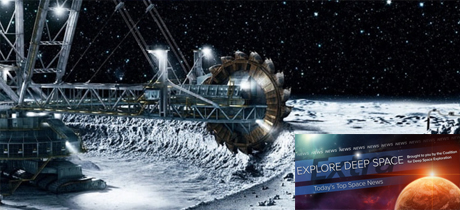In Today’s Deep Space Extra… Investors in commercial space opportunities are generating interest in resources that might be mined from the moon, asteroids and other planetary bodies.
Human Space Exploration
The common burden of “space mankind”
The Space Review (7/10): Investors in commercial space opportunities are generating interest in resources that might be mined from the moon, asteroids and other planetary bodies. But establishing who profits is proving a challenge, writes legal scholar Kamil Muzyka. Are the rewards subject to a Common Heritage of Mankind? The 1998 International Space Station intergovernmental agreement may serve as a model for space resource acquisition and reward, he explains.
In Beijing, China rolls out the red carpet and a comprehensive space plan
Space News (7/10 online, 6/19, in print): Chinese presentations before the June meeting of the Global Space Exploration Conference in Beijing revealed a clear direction and high level backing for a range of space activities. They include a staffed Earth orbiting space station, with a core module launch planned for 2019, and a human lunar presence by 2030. Robotic missions to Mars include an independent robotic mission in 2020 and a planned sample return by 2030. Jupiter and Uranus represent future destinations.
Space Science
NASA planning August release of Mars robotic exploration architecture
Space News (7/10): Key points of interest with release of a future Mars architecture include plans for a 2022 Mars Orbiter to replace NASA’s aging Mars Reconnaissance Orbiter, whose accomplishments include the discovery of subsurface ice deposits on the red planet, and plans to return samples of Martian soil and rock gathered by the Mars 2020 rover. Funding is a concern.
Juno spacecraft completes successful Great Red Spot flyover
Cosmos Magazine (7/11): NASA’s Juno mission spacecraft, in orbit around the planet Jupiter for just over a year, sped low over the giant planet’s famous Great Red Spot late Monday. The probe is making a series of low altitude science passes over the planet’s cloud tops to learn more of Jupiter’s atmosphere and powerful magnetic field. The Great Red Spot, about 10,000 miles wide, is thought to be a powerful, long lived storm with a mysterious low level heat source.
Where and how to see the total eclipse this summer in the U.S.
New York Times (7/10): Eight spots could be prime for real time viewing of a rare U.S. coast to coast full solar eclipse on Aug. 21. They occupy spots along a path stretching from Oregon to South Carolina. The last such solar eclipse occasion was in 1918. The next is in 2045.
Other News
FAA Space Office to get budget boost from House appropriators
Spacepolicyonline.com (7/10): U.S. House appropriators recommend nearly $21.6 million in 2018 for the FAA’s Office of Commercial Space, which is responsible for licensing U.S. commercial space launches. The Commercial Space Office received $19.8 million for 2017, but the White House request for the fiscal year starting Oct. 1 was for $2 million less.
Creating trends in space: An interview with NanoRacks CEO Jeffrey Manber
Spaceflight Insider and Astrowatch.net (7/10): NanoRacks founder Jeff Manber sees a bright future for commercial space enterprise. His Houston-based company has pioneered a range of commercial activities aboard the International Space Station, including CubeSat mission launches and soon an Airlock. “The industry is on the cusp of having space be just another place to do business,” said Manber.
Remote Highland peninsula earmarked for satellite launchpad
Scotsman (7/9): Britain looks to Scotland for the site of its first space launch complex. The U.S. aerospace company Lockheed Martin is among those working with the UK space agency on the planning.
Iran’s space program: A political football amidst economic decrepitude
Space Watch Middle East (7/10): In the space of one week Iranian space officials have simultaneously announced plans to start their own satellite navigation program and that an old satellite built by an Italian company is too expensive to launch and so will be consigned to a space museum.
India-Israel space ties to get a boost
The Hindu Business Line (7/11): India and Israel have had a low-key cooperation in the space sector for about a decade now. The recent visit of Prime Minister Narendra Modi to Israel is set to further the ties with an agreement that is expected to grow in scope and deepen developments.

